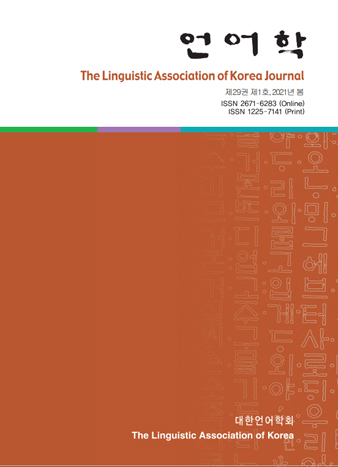대한언어학회 전자저널

29권 1호 (2021년 3월)
- Resolution of Wh/Quantifier Scope Ambiguityin Native and Nonnative Language Processing
-
Youngjae An
Pages : 93-113
Abstract
An, Youngjae. (2021). Resolution of wh/quantifier scope ambiguity in native and nonnative language processing. The Linguistic Association of Korea Journal, 29(1), 93-113. This study makes an attempt to identify how and when native (L1) and nonnative (L2) speakers of English make use of syntactic knowledge and nonsyntactic contextual information to resolve wh/quantifier scope ambiguity during online sentence processing. The question addressed in this research is investigated in the context of weak crossover phenomena (Chiercia, 1993). 19 native speakers of English and 32 Korean speakers of English participated in a self-paced reading experiment; the Korean speakers are further divided into advanced and intermediate group. The results show that L1 and L2 speakers are able to integrate the syntactic information with the contextual information in resolving wh/quantifier scope ambiguity online, suggesting that the ambiguity is influenced by the contextual information (Villalta, 2003). The findings also show that L2 proficiency is not a predictor of L2 speakers use of the target syntactic knowledge online. More importantly, the results indicate that L1 and L2 speakers employ similar strategies in resolving wh/quantifier scope ambiguity online, supporting the view that L2 processing is not fundamentally different from L1 processing (An 2019; Dekydtspotter et al., 2006).
Keywords
# wh-word # universal quantifier # scope ambiguity # sentence processing # self-paced reading
References
- Ahn, S.-H. (1990). Korean quantification and universal grammar. Unpublished doctoral dissertation, University of Connecticut, Storrs, CT.
- An, Y.-J. (2019). Online application of Principle C in L2 pronoun resolution: Evidence from self-paced reading. The Journal of Studies in Language, 35(1), 85-95.
- Aoun, J., & Li, Y.-H. A. (1993). Syntax of scope. Cambridge, MA: MIT Press.
- Beck, S. (1996). Quantified structures as barriers for LF movement. Natural Language Semantics, 4, 1-56.
- Bley-Vroman, R. (1990). The logical problem of foreign language learning. Linguistic Analysis, 20, 3-49.
- Chierchia, G. (1993). Questions with quantifiers. Natural Language Semantics, 1, 181-234.
- Choe, J.-H. (2005). Structures and semantic interpretations of Korean universal quantifier construnction. Hankul, 267, 89-118.
- Choi, Y.-S. (2003). QP and wh-scope interaction: How questions are answered. Studies in Generative Grammar, 13(1), 61-76.
- Chomsky, N. (1981). Lectures on government and binding: The Pisa lectures. Dordrecht: Foris.
- Clahsen, H., & Felser, C. (2006). Grammatical processing in language learners. Applied Psycholinguistics, 27, 3-42.
- Clifton, C., & Frazier, L. (1989). Comprehending sentences with long distance dependencies. In G. N. Carlson & M. Tanenhaus (Eds.), Linguistic structure in language processing (pp. 273-317). Boston: Kluwer Academic Publishers.
- Crain, S., & Steedman, M. (1985). On not being led up the garden path: The use of context by the psychological parser. In D. Dowty, L. Kartunnen, & A. Zwicky (Eds.), Natural language parsing (pp. 320-358). Cambridge: Cambridge University Press.
- Dekydtspotter, L., Schwartz, B., & Sprouse, R. (2006). The comparative fallacy in L2 processing research. In Proceedings of the 8th Generative Approaches to Second Language Acquisition Conference, 33-40.
- Hornstein, N. (1995). Logical form: From GB to minimalism. Oxford: Blackwell.
- Just, M. A., & Carpenter, P. A. (1980). A theory of reading: From eye fixations to comprehension. Psychological Review, 87, 329-354.
- Kim, K.-S. (2003). QR and minimalism. Studies in Modern Grammar, 31, 47-69.
- Kuno, S., Takami, K., & Wu, Y. (1999). Quantifier scope in English, Chinese, and Japanese. Language, 75(1), 63-111.
- Marinis, T., Roberts, L., Felser, C., & Clahsen, H. (2005). Gaps in second language processing. Studies in Second Language Acquisition, 27(1), 53-78.
- May, R. (1985). Logical form: Its structure and derivation. Cambridge, MA: MIT Press.
- Oxford University Press., University of Cambridge., & Association of Language Testers in Europe. (2001). Quick placement test: Paper and pen test. Oxford: Oxford University Press.
- Peirce, J. W. (2007). PsychoPy psychophysics software in Python. Journal of Neuroscience Methods, 162, 8-13.
- Pesetsky, D. (1982). Paths and categories. Unpublished doctoral dissertation, MIT, Cambridge, MA.
- Postal, P. (1971). Crossover phenomena. New York: Holt, Rinehart and Winston, Inc.
- Schwartz, B. D., & Sprouse, R. A. (1996). L2 cognitive states and the Full Transfer/Full Access model. Second Language Research, 12, 40-72.
- Sloan, K. (1991). Quantifier-wh interaction. MIT Working Papers in Linguistics, 13, 219–237.
- Suh, J.-H. (1990). Scope phenomena and aspects of Korean syntax. Unpublished doctoral dissertation, University of Southern California, Los Angeles, CA.
- Villalta, E. (2003). The role of context in the resolution of quantifier scope ambiguities. Journal of Semantics, 20(2), 115-162.
- Wasow, T. (1972). Anaphoric relations in English. Unpublished doctoral dissertation, MIT, Cambridge, MA.
- Williams, J. N., Mobius, P., & Kim, C.-K. (2001). Native and non-native processing of English wh-questions: Parsing strategies and plausibility constraints. Applied Psycholinguistics, 22(4), 509–540.
- Yang, D.-W. (1991). A comparative study on quantified expressions between English and Korean. Linguisitic Journal of Korea, 16(2), 331-356.